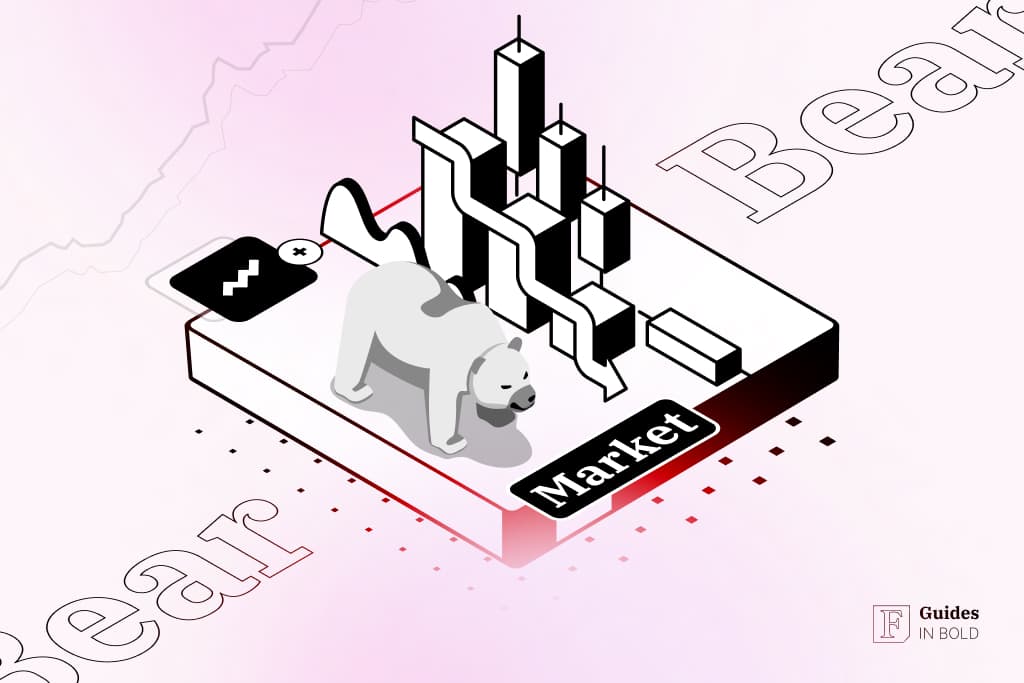A bear market is a term commonly used by investors to describe the current market situation. The following guide will explain what a bear or a down market is, the leading indicators and characteristics, as well as provide some examples. You’ll also learn how bear markets coincide with the market and economic cycles, including which investment strategies are more prevalent during a bear market.
Best Crypto Exchange for Intermediate Traders and Investors
-
Invest in cryptocurrencies and 3,000+ other assets including stocks and precious metals.
-
0% commission on stocks - buy in bulk or just a fraction from as little as $10. Other fees apply. For more information, visit etoro.com/trading/fees.
-
Copy top-performing traders in real time, automatically.
-
eToro USA is registered with FINRA for securities trading.
Summary
– Bear market definition: sustained price drop (20%+), low investor confidence;
– Driven by weak economy, rising unemployment, falling profits;
– Key indicators: declining GDP, business profits, stock values, and sentiment;
– Can be secular (long-term) or cyclical (short-term);
– Often follows economic contraction; end confirmed in hindsight;
– Strategies: shift to bonds, defensive stocks, diversify, avoid panic selling;
– Notable examples: 1929 Great Depression, 2000 Dot-com crash, 2008 Financial crisis, 2020 Covid crash;
– Opposite: bull market (rising prices, positive sentiment).
What is a bear market?
The term bear or down market is commonly associated with declining prices in stock markets. Still, it can also describe price fluctuations in other highly volatile sectors that are impacted by consumer confidence, such as bonds, real estate, or commodities like gold, oil, or gas.
Two of the most used idiomatic expressions in finance are “bearish” and “bullish.”
The phrase “bearish” refers to the downward swiping motion of a bear’s claws and metaphorically downward momentum in the market. In contrast, bulls aggressively thrust their horns upward, indicating the opposite movement in the market; in general, both terms mean price swings in the market as a whole.
Beginners’ corner:
- What is Investing? Putting Money to Work
- 17 Common Investing Mistakes to Avoid
- 15 Top-Rated Investment Books of All Time
- How to Buy Stocks? Complete Beginner’s Guide
- 10 Best Stock Trading Books for Beginners
- 6 Basic Rules of Investing
- Dividend Investing for Beginners
- 5 Passive Income Investment Ideas
What is the key indicator of a bear market?
Down markets tend to occur during the economic slowdown and rising unemployment, which fuels pessimistic investor sentiment. As people start to worry, they decrease the number of investments or decide to sell their stocks completely. Instead of buying, investors want to sell in exchange for cash or more secure income securities.
It leads to an increase in supply and lowers the demand, causing an oversaturated market and falling stock prices. A declining market is characterized by low investor confidence, declining prices, increased supply vs. demand, and consumer pessimism.
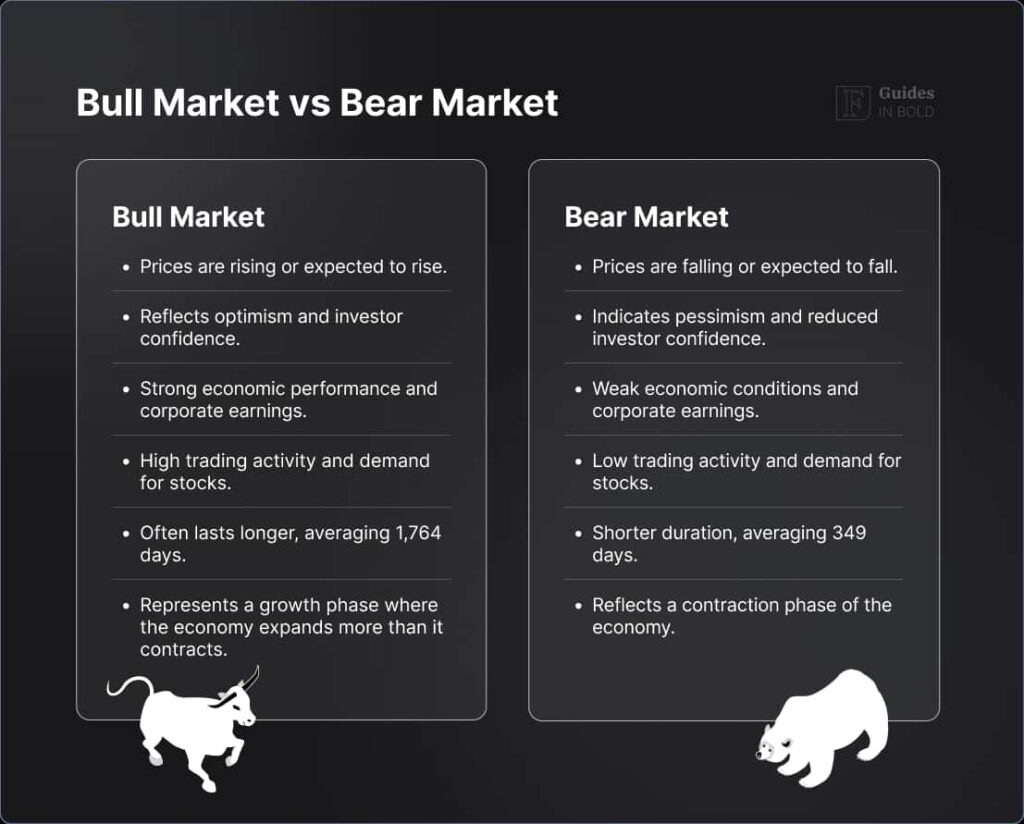
How long do bear markets last?
Full-blown bear markets can last anywhere from weeks to months or even years and can be either cyclical or long-term – a full-blown down market is when prices are experiencing prolonged declines that span across several years.
As opposed to bull markets, bear markets tend to be shorter and last for 349 days on average, whereas growing markets can go on for around 1,764 days. The market generally spends more time in a bull phase than a bear phase, meaning that the market or economy is growing more than contracting.
Moreover, bear markets tend to have fewer price fluctuations – bull markets experience an average growth of 180%. In contrast, down markets suffer from a loss of 36%, according to an analysis by Invesco.
What is more, a bear market doesn’t always imply that all asset classes are in the same phases of their respective cycles. For example, stocks can be in a down market, whereas commodity prices can still increase.
Secular vs. Cyclical bear markets
As down markets can last anywhere from weeks to years, the length defines the type of a bear market: a secular or a cyclical bear market.
A secular or a long-term bear market is a phase where the prices keep declining over a longer period of time, anywhere from 10 to 20 years and are characterized by below-average returns. During this period, bear market rallies may occur, meaning it seems prices are heading towards a bull market, whereas it ends up being a market correction phase in an overall declining market.
A cyclical, or a short-term bear market, on the other hand, is where prices decrease over a shorter time period, over a few weeks or months. Therefore, these are less severe and occur more frequently due to normal market volatility.
4 stages of the economic cycle
A down or a bear market can describe any asset classes affected by the economic cycle that can either gain or lose value over time. All of which are characterized by a cyclical rise and fall in prices across the four economic cycles – expansion, peak, contraction, and through.
To understand how bear and bull markets work in line with the economic decline, let’s have a look at the four stages of the economic or business cycle, which follow a wave-like pattern, as seen on the graph below.
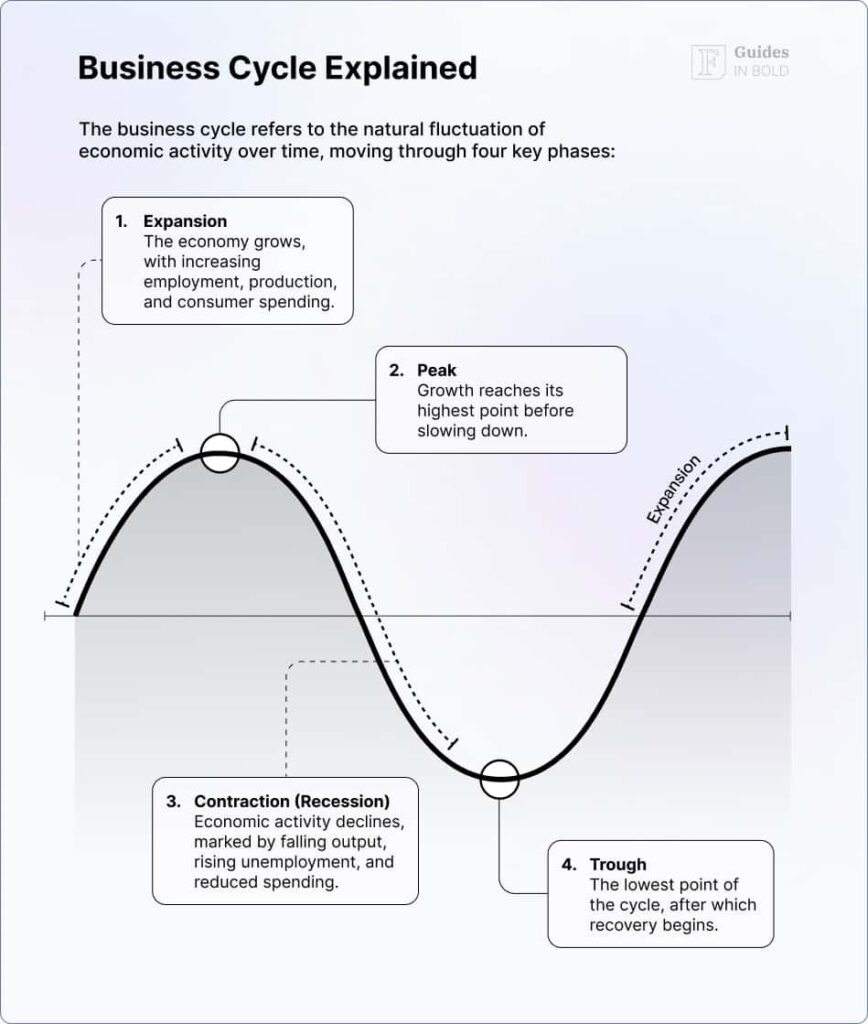
When investors start to sell at the beginning of a bear market, it can indicate a declining economy and looming recession. The contraction begins after reaching the peak phase, bringing a bear market. Once the economy is in the expansion phase again, a bull market will likely start.
4 stages of a market cycle
The two terms, a business cycle, and a market cycle are often confused and used interchangeably. However, while the business or economic cycle refers to the economy as a whole, a market cycle describes fluctuations specifically in the stock market.
Therefore, four stages of a market cycle describe increases and decreases in the stock market: accumulation, markup, distribution, and decline. The below graph illustrates these four phases and market fluctuations.
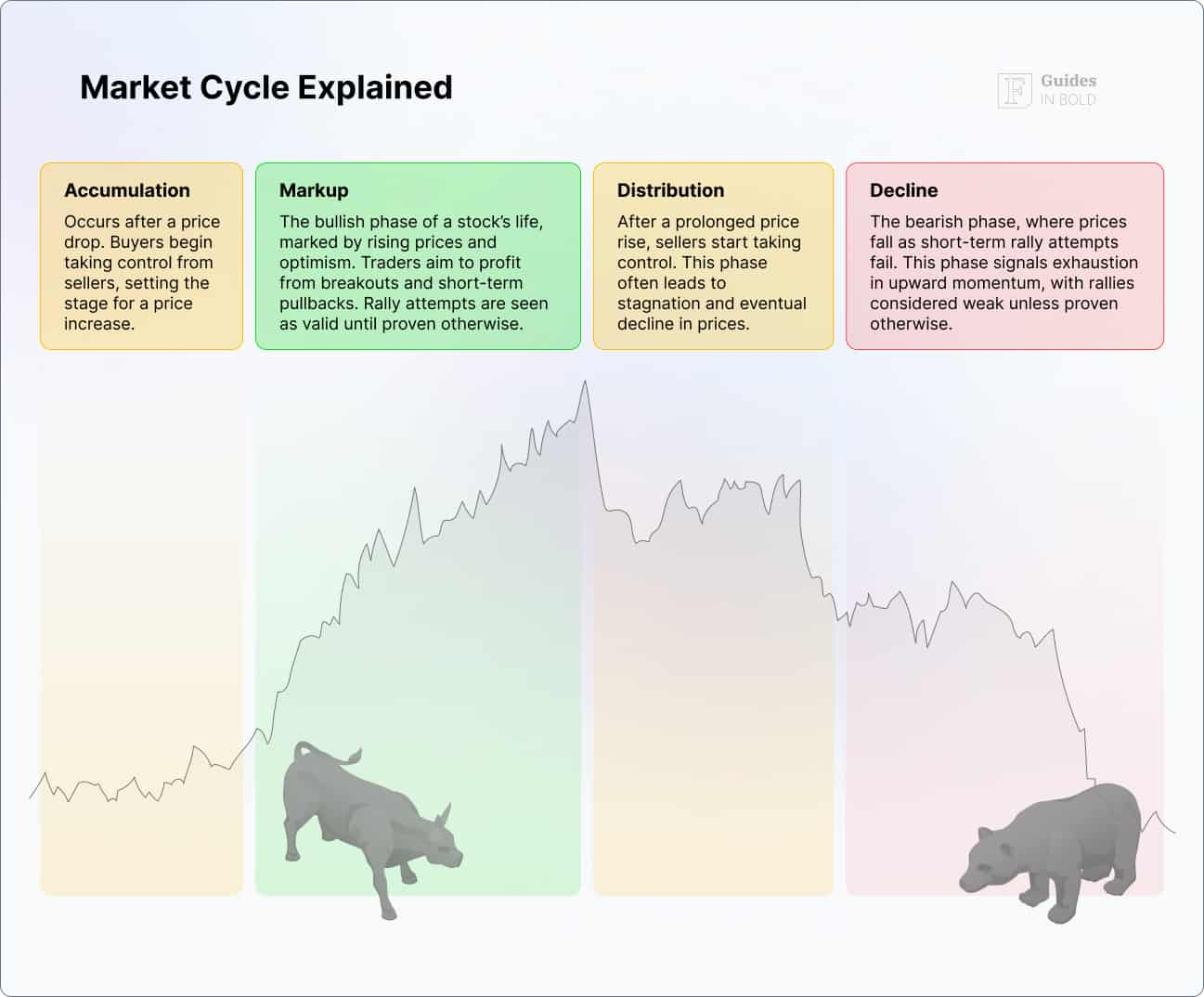
Bear markets follow bull markets, and bull markets follow bear markets, and so on. A continuous decline in prices and a pessimistic economic outlook will result in a bear market.
However, as the economy improves, a turnaround occurs, and investors get more “bullish.” A bear market ends once prices have dropped to a level where they can’t drop anymore, and investor sentiment begins to improve along with consumer confidence. Prices continue to climb, and after stocks gain 20% or more, a bear market is considered over, and a new bull market begins.
Best Crypto Exchange for Intermediate Traders and Investors
-
Invest in cryptocurrencies and 3,000+ other assets including stocks and precious metals.
-
0% commission on stocks - buy in bulk or just a fraction from as little as $10. Other fees apply. For more information, visit etoro.com/trading/fees.
-
Copy top-performing traders in real time, automatically.
-
eToro USA is registered with FINRA for securities trading.
After some time, markets will reach irrational exuberance, which causes prices to increase excessively and result in overvalued assets. Then investors begin to sell, which causes prices to fall again, creating a seller’s market and bringing a new bear market.
The chart below shows how the stock market has been trading since the 1930’s Great Depression, both in bear and bull market cycles.

However, as markets are in constant flux, the gains and losses can offset each other due to smaller increases and decreases in prices.
Bear market vs. Market correction vs. Pullback
Let’s briefly touch upon these three terms, as they are helpful to know when making your investment decisions. Assuming the market will drop into a full-blown bear can lead to panic, poor decision-making, and early selling of shares. However, price fluctuations in the market are normal and can be less severe.
- A pullback is a drop of 5% to 10% that is only short-term, usually lasting a few days or weeks. It is a normal adjustment phase – a slight deviation from a recent high, while the overall trend remains the same.
- A market correction is where prices decrease between 10% to 20% and usually last two to four months. These phases are highly volatile and can make investors fear that a bear market is coming and decide to sell. Nowadays, real-time news can intensify these fears, as investors may be impacted by crowd psychology and take preemptive decisions.
- A bear market is where prices drop by 20% or more and usually last anywhere from months to several years. Investor confidence is already shattered, and money is lost. More and more people begin to sell their stocks to stop further losses; therefore, trading activity declines.
Difference between a bear and bull market
A bull market is the opposite of a bear market, where prices of stocks, assets, or securities are rising over a period of time. While in a bear phase, the market drops by 20% or more, in a bull phase, it increases by 20% or more from the most recent low.
Bull market – substantial market growth over a sustained period of time.
Bear market – substantial market decline over a sustained period of time.
A rising or bull market occurs in a growing and healthy economy with low unemployment, driven by high investor and consumer confidence. As opposed to the bear phase, investors are keen to buy and hold rather than sell, which in turn, further grows a bull market.
Like down markets, a rising market doesn’t only apply to stock markets but can also describe price fluctuations in other sectors such as bonds, currencies, real estate, commodities, or any other asset classes.
Bear market indicators and characteristics
It is impossible to predict the exact date a bear market begins, and prices will drop; there are, however, main characteristics that can describe and indicate we are in a down market. Once stock prices have peaked, it is difficult to determine if the market is experiencing a correction or a full-blown bear market, along with a recession, is on its way.
1. Unstable and declining economy
Bear markets often coincide with an unstable and weak economy, where unemployment is high and gross domestic product (GDP) declining. Overall, consumer confidence is low, as people have less disposable income, and business productivity is weak – money becoming tight leads to the risk of deflation.
What is more, government interventions, wars, political movements, or in the current case, pandemics, can also trigger a bear market.
However, it doesn’t necessarily mean a recession is coming when the market is down. There have been 26 bear markets in the US since the Great Depression, out of which only 15 of them happened during a recession. Although down markets often occur during periods of economic slowdown, it doesn’t necessarily mean a recession is coming.
2. Low business profitability
Businesses are also affected by the economic downturn, as when the overall consumer spending decreases and money becomes tight, productivity falls. Corporate profits start to decline, and growth stagnates, which leads to layoffs and budget cuts.
When investors notice a declining economy, they become worried that the corporate profits will also fall, along with their investments. For that reason, people start to sell their stocks, which increases supply and lowers demand, leading to low prices.
And that is why a bear market can be a signal of a looming recession or more challenging economic times ahead.
3. Negative investor sentiment
A weak economy and low business profitability would naturally decrease the interest in investors, who would then start selling their shares.
A consensus would form that the market has stopped growing and won’t revert any time soon. More and more investors would stop buying, feel it is safer to sell, or move their money to less volatile assets.
Investment strategies differ in bear markets vs. bull markets. Investors in a down market are pessimistic about the outlook and more risk-averse, which is the opposite of a bull market, where people tend to be more risk-seeking.
4. Declining stock values
Another clear indicator of a bear market is declining stock prices. As more investors decide to sell or stop buying stocks, it increases the supply and lowers the demand, and in turn, negatively affects the value of stocks.
Moreover, listed companies will seem less on paper due to low stock prices and lose some of their actual value. Stock prices also reflect investor expectations of future company profitability, and fear of further losses stops growth.
Notable bear market examples
Since 1929, there have been 26 bear markets in the S&P 500 stock market index. Some of them have been longer and more severe than others, which is why they have been analyzed and widely discussed in the media.
To get a good understanding of what a bear market is, let’s bring out some of the most notorious and severe ones, starting with the Great Depression and the Wall Street Crash of 1929.
1. The Great Depression of 1929
The Great Depression was one of the most prolonged and most severe global recessions that started in 1929. Economies around the world didn’t begin to recover until the late 1930s. Some say that the US stock market crash of 1929 was the catalyst; others say it was a byproduct rather than the cause.
The Wall Street Crash of 1929 was a sudden and steep crash that saw share prices plummeting in the New York Stock Exchange. This crash was followed by the London Stock Exchange Crash, all of which signaled the beginning of the Great Depression, an era followed by the “Roaring Twenties,” a post-war time of wealth and excess.
The cause of the crash was due to over speculation that the market would keep rising as more and more people started investing. The Dow lost nearly 13% of its value in one day on October 28th in 1929.

2. Black Monday 1987
The infamous global market crash, later named Black Monday, was sudden, the most severe since the Great Depression in 1929. On October 19th in 1987, twenty-three major stock markets worldwide experienced an extreme decline of between 20% to 40%, sparking a severe yet relatively short-lived impact on the global economy.

3. Dot-com bubble 2000 – 2002
The late 1990s was a period of growth for several new tech companies, including Google, Amazon (NASDAQ: AMZN), and Yahoo!, as the broader adoption of the Internet drove market growth. The S&P 500 surged by over 400% but crashed in March 2000 when S&P 500 decreased 49%, recovering in 2002.
Positive investor sentiment and over-speculation drove prices so high they were no longer justified. As investors kept buying into stocks in dot-com companies, supply started to overtake the demand. More businesses decided to go public, often without a proper plan, yet still lured investors to unprofitable companies.
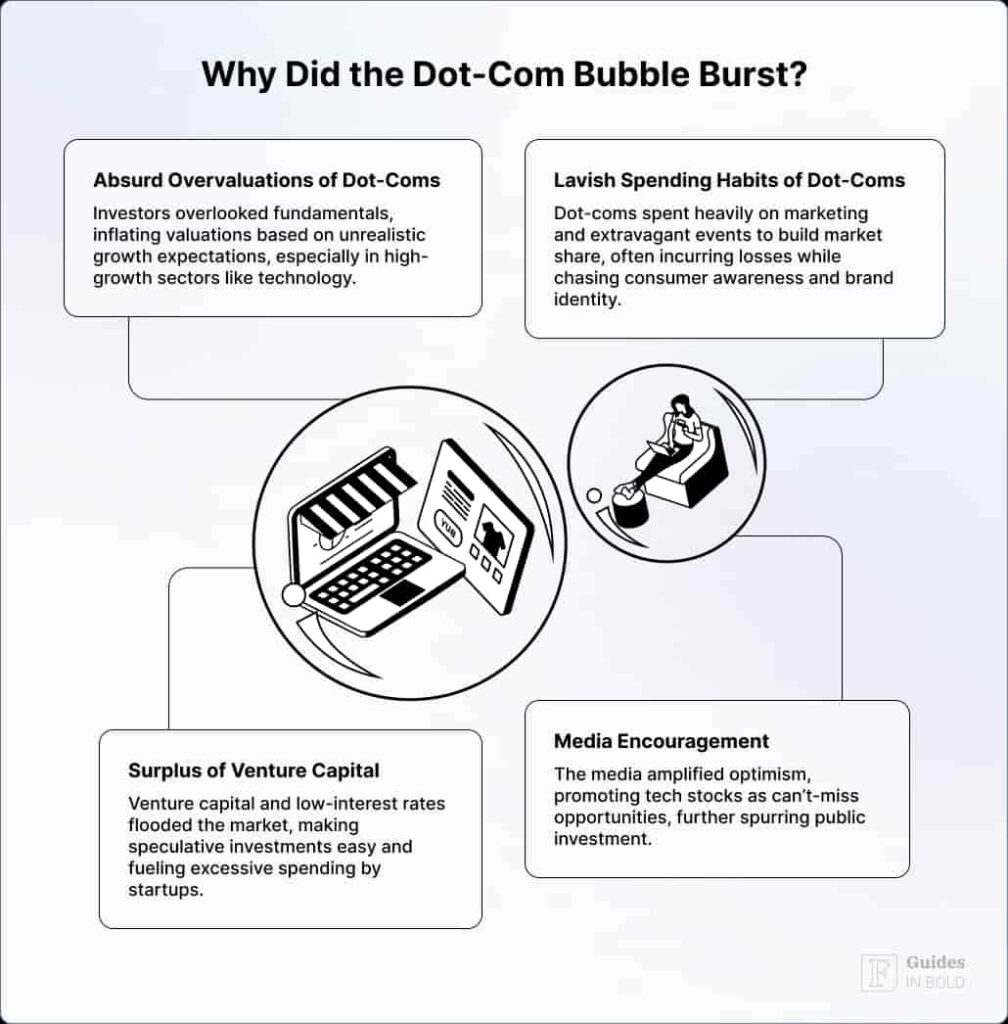
4. The Financial Crisis of 2007 – 2009
The global financial crisis of 2007 to 2008 was the most severe bear market after the Great Depression, driven by the housing crisis and excessive risk-taking by financial institutions. Mortgage-backed securities (MBS), composed of subprime loans, played a central role in the collapse, as their widespread default caused significant losses for investors. The crash culminated with the bankruptcy of the Lehman Brothers in September 2008, creating a worldwide banking crisis.
These events led to the S&P 500 losing about 50%, but the market started increasing again in 2009 and entered a bull run that ended in February 2020.
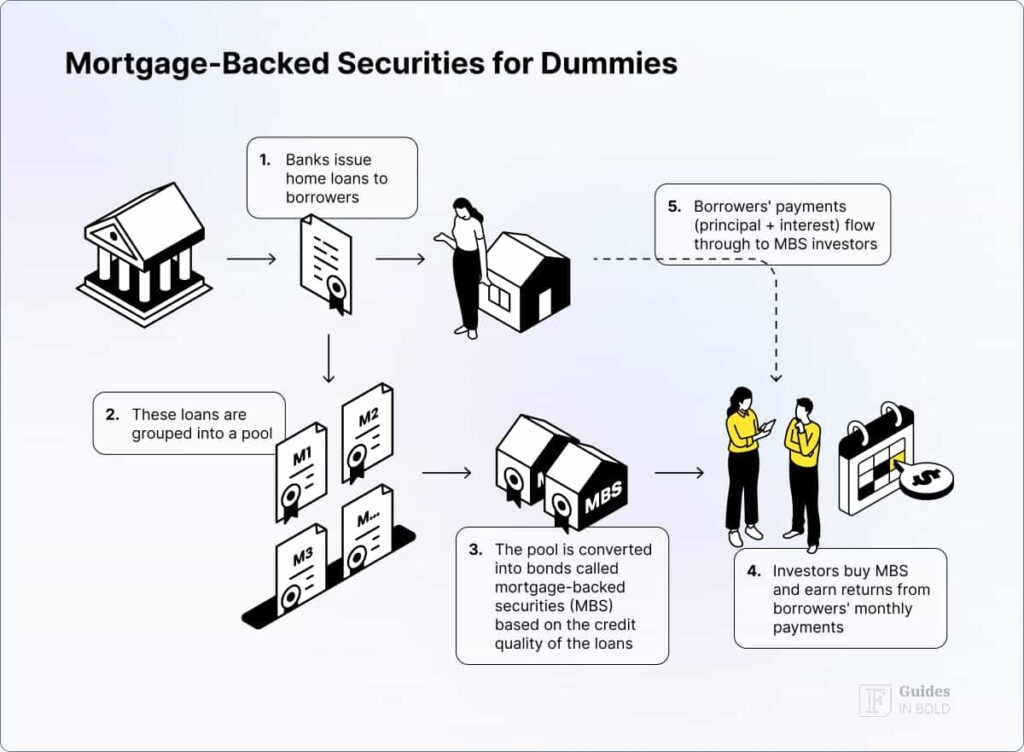
5. The Covid-19 pandemic crash 2020
A bear market often occurs just before or after the economy starts to decline, but it could also be driven by political events like wars, or in the most recent case, a pandemic.
The longest-ever bull market run started in 2009 after the financial crisis ended abruptly in February 2020, driven by the global Covid-19 pandemic. Stock markets plummeted suddenly over the course of a few weeks and entered a bear market.
The S&P 500 stock index dropped 51% between the 18th of February and 23rd of March, in line with the shortest ever recorded recession when Covid-19 lockdowns contracted the GDP by 31%, worse than during the Great Depression.
However, the economy and the stock markets made a speedy recovery, and by Q3 2021, the GDP growth was back at 2%. The S&P 500 stock index also entered a growth phase again at the end of March, amid the announcement of successful Pfizer (NYSE: PFE) vaccine trials. Since then, prices have reached an overall high and entered a bull market again.

Bear market investing strategies
Due to the long decline in prices during bear markets, it is common for investors to adapt and start changing their investing strategies. For example, capitalizing on assets or bonds rather than stocks can be more stable and have better returns during bear markets.
A few things to note about investing in bear markets:
- Prepare by adapting the portfolio to reduce risk, such as lowering the number of high-risk stocks and increasing the number of assets, commodities, or bonds that may perform better during bear markets.
- Select mutual funds or bonds, such as gold funds or consumer staples – during down markets, individual bonds are safer than bond funds, as they have fixed interest rates payments.
- Don’t panic and sell stocks prematurely or all at once. Take a step back and evaluate to see which ones are more likely to recover and which ones are looking at a long-term decline. If you decide to sell, think about getting rid of around 5% – 10% at one time and see how things develop.
- Stick to safe bets or staples, for example, healthcare. Companies that have survived or even grown during previous downturns are more likely to hold their value this time around.
- Capitalize on low-priced stocks that are likely to increase in value once a bear market phase is over. But don’t overdo it and get too risky – pay attention to which stocks are likely to bring a good return on investment and which ones are low in value for a reason.
In conclusion
No one can precisely predict when we are about to enter a bear market, but there are several tell-tale signs to keep an eye on. Instead of speculating and predicting what will happen in the market in the future, try to ensure an optimal and well-balanced portfolio.
Diversify your portfolio, and ensure you only invest the money you can manage without for the next few years. This way, you don’t have to sell and can ride a bear market out until markets increase and improve again. It is hard to predict the patterns and what can happen in the future, as the sudden onset of the Covid-19 pandemic proved to us.
But through understanding the market trends and general main economic influences, one can better know where to invest, when to invest, and how much to invest. Bearish and bullish behavior reflects how much is also dependent on investor sentiment as if some people begin selling, others will follow.
Finally, create a solid financial plan and de-risk your portfolio to manage your investments better. It will help avoid making any bad decisions based on emotions or taking unreasonable risks based on your fear that the stock market will crash.
Disclaimer: The content on this site should not be considered investment advice. Investing is speculative. When investing, your capital is at risk.
FAQs about what is bear market
What does the term bear market mean?
When the price of a market continues to decline for a lengthy period of time, the market is considered to be in a bear market. It is often used to describe a scenario in which the price of assets has fallen by at least 20% from recent highs as a consequence of a lack of investor confidence. It is also possible for bear markets to develop in combination with larger economic downturns, such as a recession.
What are some examples of a bear market?
The Great Depression was the first and most well-known bear market in history. Other instances include the dot-com bubble of 2000 and the housing crisis of 2007–2008.
How do I protect myself against a bear market?
When the market enters a bear market, having a well-balanced portfolio is one of the most effective ways to preserve your investments. You should have some rising stocks in your portfolio that you can profit from and reinvest into more conservative assets such as government bonds, gold, or exchange-traded funds (ETFs) based on your risk tolerance and investment objectives.
How to predict when a bear market will start?
Interest rates are one of the most dependable indications when it comes to identifying whether or not a bear market is about to break out. In any case, when the Federal Reserve lowers interest rates in response to a slowing economy, it is a strong indicator that the market may be on the verge of entering a bear market shortly thereafter. However, there are other instances in which a bear market begins even before interest rates are reduced.
Should you buy in a bear market?
Yes, buying in a bear market can be a smart long-term move if you’re financially stable and invest in fundamentally strong assets at discounted prices. It allows you to buy low and potentially gain when the market recovers.
